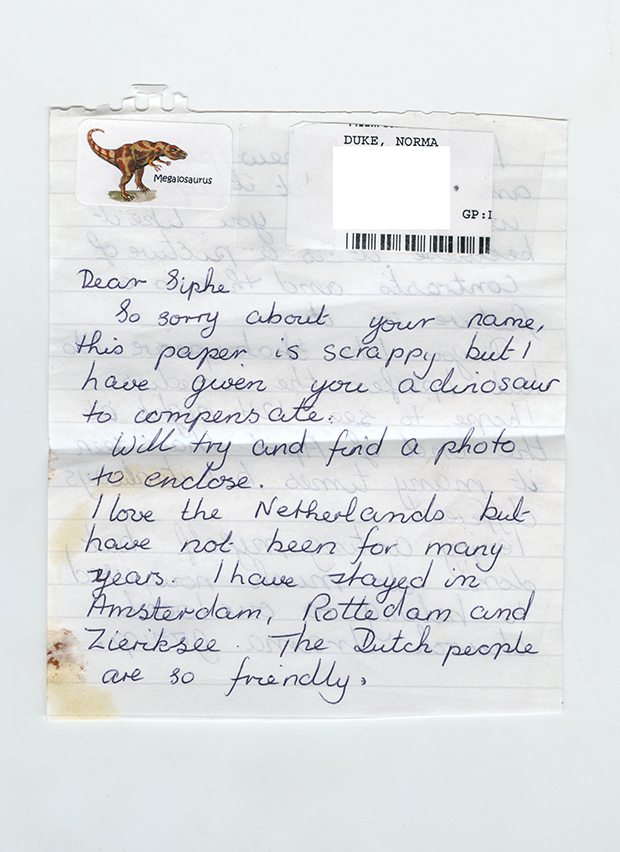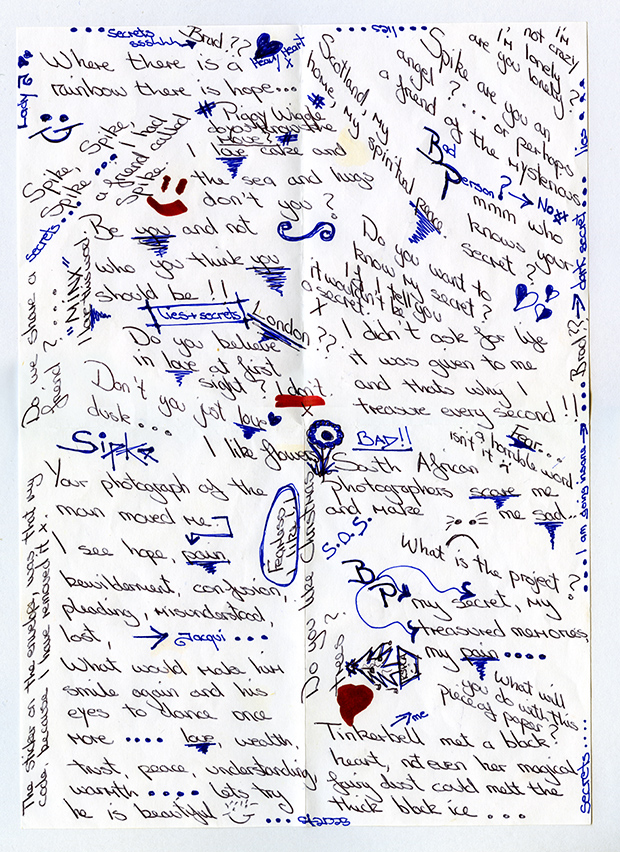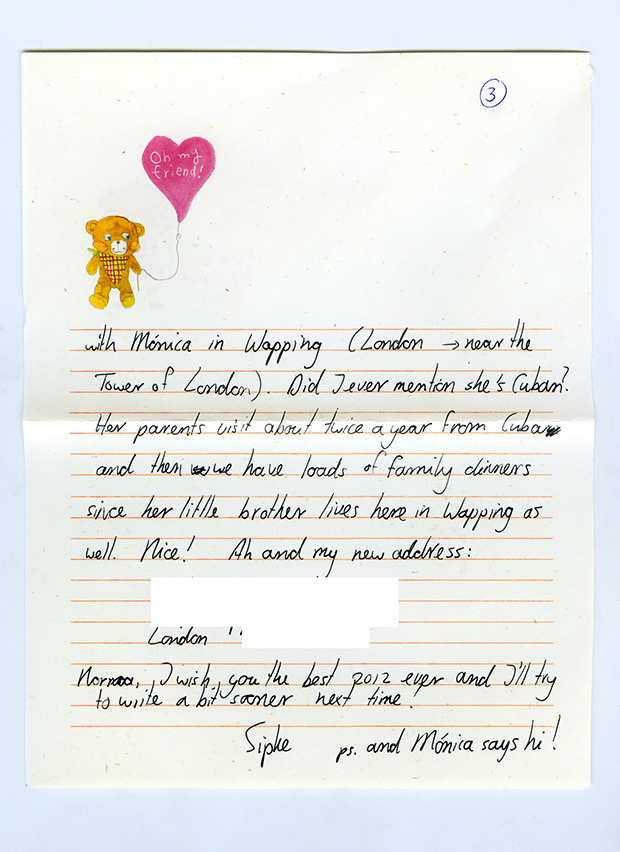Feb 13, 2013 | books, interviews
Sipke Visser grew up in the northern Netherlands, but currently resides in Wapping, London. All of his works involve strangers, and this time connecting strangers – people who otherwise would have no knowledge of the other’s existence. Sipke “aims to photograph those intimate moments when people are immersed in themselves or with each other,” and for this project Return to Sender, Sipke sent those photographs to hundreds of random addresses across the UK. Included with these photographs was a stamped and addressed return envelope along with a handwritten letter asking for a very open-ended response – either to the photograph, about your day, a random thought, anything really.
Return to Sender was recently published as a 480 page book, a careful recording of the correspondences that came from each of the 500 letters that Sipke sent over the course of two and a half years. He found the addresses at random on GoogleMaps, sending a few of the letters to the US as well. A random human response survey that allows for any sort of reply, using what’s almost now an archaic form of communication – although it is the only one that still remains somewhat physical.
This post contains images of the photographs sent and letters received, courtesy of the artist.

Did you ever have a pen pal when you were little? Do you often used the postal system to communicate with people, even if it’s just for the novelty of it?
I must have at some point but to be honest I don’t remember at all. If my penpal from back then remembers, please let me know!
When did the idea for Return to Sender strike you? Was it always intended to turn into a book?
It was in the autumn of 2008 and I was having take away dinner with three friends in yet another friends home in Amsterdam. One of them had been a postman for a while which we were talking about and then suddenly it struck me that it would be fun sending images to random strangers. The foreword in the book is written by one of these friends, the one who used to be a postman.

Which responses did you like the most? How often did the responses mention or relate to the photograph you’d sent them?
The one that stands out most is Norma since we kept on writing. There are many letters written by both of us to each other on the book. She writes about everything that happens to her. About her children, her grandchildren, her mum (who passed away at some point). I
write about what I do, my love life, London, etc. There is a guy called Donald who sent me pictures of himself and his sun. There is a beautiful one of a lady whose mother in law is not doing very well but who is very religious. The image she received happens to be religious and she writes how special that was for her. There is an A4 full of doodles by someone anonymous. And also some very rude or aggressive ones that are quite funny once you get past the rudeness – although I was a bit offended when receiving them.
Some people do talk about the image they received, but many others don’t.
What do you hope the readers of Return to Sender take away from both the book and the project as a whole?
For me it was about many things but I think the main thing is the idea that complete strangers receives a letter and a photo in the post without expecting it at all. And I’m so curious to where they ended up and I love receiving post and finding out. I think I just hope people will enjoy reading the responses and perhaps like the pictures. It’s a book you can open up on any page and since it’s a lot of pages you might find something new many times.

What other sorts of projects have you done previously and what do you think you’ll do next?
A few years ago I was very busy with work (I make most of my living as a retoucher) and barely had time to shoot so I thought it would be a good idea to invite people to my place to photograph them for an hour or so. I put an ad out on a website called Gumtree which I think is similar to Craigs List. Over 30 people visited me in about a years time and I took their portraits. The images and some text are on my website. I also once rented an empty room for a month and invited strangers over for an hour. All that was in the room was coffee, tea, an old 35mm camera with one lens and me. The light in the room was terrible and the pictures not great but it was a great way of spending time with a subject and a camera and nothing else. And I’ve got a great number of projects in my head that I want to do now, but I’m not saying what yet. The best way to stay up to date is to visit www.asortofdiary.com

{About A Sort of Diary: the website Sipke started when he moved to London from Amsterdam in 2005 to start a life in photography. A Sort of Diary is a visual outlet for what has kept him busy over the years. Not quite a blog, not quite a website, more a …. sort of diary. His eye for a great off-beat moment, combined with humorous comments and observations on the friends, family and strangers (not to mention animals) in the photos leave you feeling as though you’ve come to know him personally.}


For more of Sipke’s work, see his website.
Feb 5, 2013 | painting, sculpture
I’ve always found the whole “paragone” thing so interesting. Paragone is the Italian Renaissance word for the competition between different media, often referred to as the competition between the arts. In the contemporary art world the idea doesn’t really translate since media are often crossed over and blended, either in one image on a computer or physically in one place. Most artists today refuse to classify as themselves as a “painter” or a “sculptor,” but I really feel like the limitations of traditional media force artists to push themselves and their craft in a way that doesn’t happen often anymore.
When artists broaden their scope to include anything and everything – concepts from every range of the human experience along with every kind of media available – there isn’t the obsessive, hyper-attuned focus that’s needed to create something powerful. All good works have to have something obsessive about them, whether it’s one idea or one media. Before photography that obsessive bit usually involved an incredible faithfulness to reality.
 |
| Triple Portrait of Cardinal de Richelieu by Philippe de Champaigne and studio, c. 1642 |
During the Italian Renaissance when this word was floated across the lofty circles of artists and patrons, that competition of the paragone was completely focused on the work’s faithfulness to reality. These patrons were paying scudi by the thousand so that us, the people who live thousands of years later, could still remember what they looked like.
The portrait bust below was completed after Bernini’s model of Cardinal Richelieu, a portrait the Cardinal didn’t sit for. Bernini created the sculpture solely from examining the painting of the Cardinal above, sent to him and completed by Philippe de Champaigne. Bernini was known to be actively involved in the paragone discussion, and this opportunity to create a portrait sculpture purely from a painting is often seen as one of the best examples of Bernini proving sculptures place among the arts.
 |
White Marble Bust of Cardinal Richelieu, after the model by Gianlorenzo Bernini
French, mid 19th century, from Christies
|
Although the painting of Cardinal Richelieu lights up the screen with all its color, at a time when works couldn’t just be reproduced a million times over, I imagine sculpture would have been the more impressive medium. It know it’s a lot easier for me to connect with an object that exists in my space rather than in a set scene somewhere far away. But painting also allows for more possibility – it can take you out of your space to an impossible one, while sculpture is limited physically, in the same ways we are.
What do you think: painting or sculpture?
Feb 1, 2013 | installation, interviews, painting
 |
| Sophia Ainslie’s mural in progress on 1/30/13 at the Kingston Gallery |
On Wednesday I was lucky enough to meet with Sophia Ainslie, a South African artist who’s currently working on a mural at the Kingston Gallery in Boston’s South End. Right now I’m working on
an Artscope post about this new show “in person,” but I needed to write something else too because it was just so incredible to watch that mural come to life.
 |
| Mural with projection. |
Sophia had three trained assistants painting while I was there, two up on ladders filling in bright colored sections and one standing, tracing the lines coming from a projector. The projector contained a zoomed in section of the wall’s intended design, made with a computer that was used to combine works from “Fragments,” the drawing series Sophia has been working on for the past four years.
 |
| Sophia Ainslie (right) instructing an assistant. |
She made a number of murals from this same series last year, but this is the first time she’s ever used assistants. She told me she wanted to see how much of the work she could give away, kind of like Sol LeWitt but without giving it all up – more like Frank Stella she said. She wants the concept to be hers, but she was still very particular about how the assistants painted, she trained them and walked them through the process, overseeing the wall’s development every step of the way. “I’m a painter,” she said, “I’m seduced by the architecture of paint.”
 |
| Paper works for “in person” at the Kingston Gallery |
The lined sections of this feathered, almost camouflage-like design, were inspired by landscapes, but the ones seen beneath her feet so that she’s involved in what surrounds her. The colored bits are abstracted interpretations of her mother’s last X-ray, before she made the decision against surgery for cancer at the age of 82. Sophia has been developing this series since her mother’s passing in 2009, and now the horizontal large-scale medium of the mural is allowing for a release, “This is more about a letting go,” she said, “all the other images were vertical and more about the body. This is a release of her.”
 |
| Sophia Ainslie (right) instructing an assistant. |
 |
| Mural with finished design taped up. |
See more of Sophia’s work on her website here.
And read more about this show in my Artscope post!
Jan 29, 2013 | collage, news, photography
My best friend loves movies and all of the incredibly beautiful people in them. A couple of summers ago she set to collecting cutouts of her favorite actors and comedians from magazines, and after a while she collaged them onto this massive sheet of purple paper – hundreds of photoshop-perfected faces looking out at you with adorably quirky smiles and teeth whiter than humanly possible. They covered the entire wall, thousands of eyeballs making one-way eye contact. After a while it felt like I was best friends with Tina Fey and Aziz Ansari, but only one very specific, perfected version of them.
 |
|
|
Everyone has made a collage at least once in their life, just like we all turn our hands into turkeys for Thanksgiving as a kid. So usually when I see art with “collage” listed as the medium, to me it just kinda seems like the artist was lazy and quit after the collecting ideas phase, because I find there’s always something lacking from art that didn’t come directly from the artist’s hand. If you’re just altering and combining things then how are you creating?
But while researching an article (that will be my first ever in PRINT! -so glad I made it before the industry died;) I found a number of collage or collage-type artists whose work is really powerful.
Even though they’re not sketching the images themselves, they’re collaging ideas, creating something new and unexpected. A lot of the times the works gain significance because some of the pieces come from older forms of media that we’re now all nostalgic over.
Julien Pacaud‘s work uses this kind of nostalgia to its advantage, creating surreal thought-provoking scenes that seem to exist in multiple dimensions. “Funny Games” casts giant children onto a vast grass landscape, gripping guns in one hand and toys in the other.
Pacaud is a French artist and illustrator who uses his work as a way to allow viewers “to transcend and transform their world as surreal qu’onirique (dream).”
Richard Vergez‘s work collages on a more conceptual level, the images often left without a background to prevent idea-interference. The backgrounds are not only blank, but a warm cream color, like that of older magazines that have yellowed gracefully.
“I make collages inspired by post-punk, Dada, and Surrealism,” said Vergez. “Loose Cannon” shows the figure of a man walking, but with thick blue cloud of smoke rising from his jacket collar instead of a neck and head and billowing out of the frame He walks across his white, empty landscape casually, a universal representation of the internal mini-freakouts when we miss a deadline or forget a payment. The kind we all hope no one notices.
 |
| Be Frank With Me by Jordan Clark. |
Jordan Clark was selected as one of the four artists for SCOPE New York’s Breeder Program showcasing this May, a program now in its 13th year of introducing emerging artists and galleries to the contemporary market. His works are more simple; pixelated portraits of some of history’s most recognizable men and vast landscapes interrupted by a central out-of-place element. Inverting conventions the way Clark does wouldn’t be possible without collage.
If you’re a collage artist or a big fan of one, comment with a URL so we can all find new kinds of image & concept convergence.
Jan 15, 2013 | painting, photography
It’s funny how art can be reinterpreted. There’s a super-human group of iconic artists, the ones every one can recognize whose incredible style gets digested and reappropriated on nearly every other artist’s canvas that came after them.
I recently came across an artist who uses faces instead of canvases for a more personal kind of reinterpretation. Andy Alcala posts “Making of” videos where you can watch him perform the coolest face painting of all time; very calm and methodical, working in front of a black sheet to match the black backwards baseball cap holding his hair back. But more impressive are the collection of final photographs – dozens of repurposed masterpieces painted onto a face facing you with eyes closed.
Below you’ll find a few of his works with their corresponding artwork beside:
“You Are So Little” by Andy Warhol, 1958
 |
| From the artist’s Flickr here. |

“The Persistence of Memory” by Salvador Dali, 1931
 |
| From the artist’s Flickr here. |

“Nympheas” by Claude Money, 1904
 |
| From the artist’s Flickr here. |

“Sailboats in Pourville” by Anna Bilinska, 1885
 |
| From the artist’s Flickr here. |

“Whaam!” by Roy Lichtenstein, 1983
 |
| From the artist’s Flickr here. |
There’s a really cool “Making of” video for “Whaam!” on Vimeo here.
Sometimes we apply these reinterpretations of artworks to the artists themselves. We’ve all seen the adorable little artist costumes, but I really love the dissected artists, the men in full costume with their insides painted the same way their hands did.
All photos from Vlamboyant.
Dissected Picasso:
Dissected Van Gogh:
Dissected Dali:































